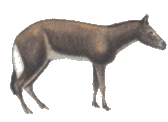
Orohippus (Gr., "mountain horse") is an extinct ancestor of the modern horse that lived in the Eocene (about 50 million years ago).
It is believed to have evolved from animals like Hyracotherium, as the earliest evidence for Orohippus appears about 2 million years after the first appearance of Hyracotherium. The anatomical differences between the two are slight: they were the same size, but Orohippus had a slimmer body, a more elongated head, slimmer forelimbs and longer hind legs, all of which are characteristics of a good jumper. The upper premolars of Orohippus are more molariform (flat-surfaced) than in Hyracotherium, giving Orohippus more teeth for grinding, and the crests on the teeth are more pronounced, indicating that Orohippus probably fed on tougher plants. The outer toes of Hyracotherium are no longer present in Orohippus, hence on each forelimb there were four fingers (toes) and on each hind leg three toes.
Orohippus has also been referred to as Protorohippus.
 Lefthit
Lefthit
No comments:
Post a Comment